Best Men’s Insulation and Midlayers of 2024
This article originally appeared on Outside
You could get by in winter stacking layers of wool sweaters--they got Norgay and Hillary up Everest after all. Modern insulating layers are oh so much lighter and better fitting though. There are giant puffy parkas that repel rain like a poncho and millimeter-thick stretch fleeces as warm as Jean Claude Killy's ski sweater. There are even layers that combine both qualities, should you find yourself, say, jogging in Antarctica.
The Winners At A Glance
La Sportiva Bristen Thermal JKT
Patagonia R2 Techface Hoodie
Outdoor Research Vigor Grid Fleece Pullover Hoodie
Jones Outerwear Ultra Re-Up Down Recycled Jacket
Odin Light Stretch Hooded Insulator 2.0
Strafe Highlands Shirt Jacket
Black Diamond Belay Parka
Rab Mythic G Jacket
Columbia Arch Rock Double Wall Elite Hooded Jacket
The Reviews: The Best Men's Insulation and Midlayers of 2024
FLEECES
La Sportiva Bristen Thermal JKT ($189)
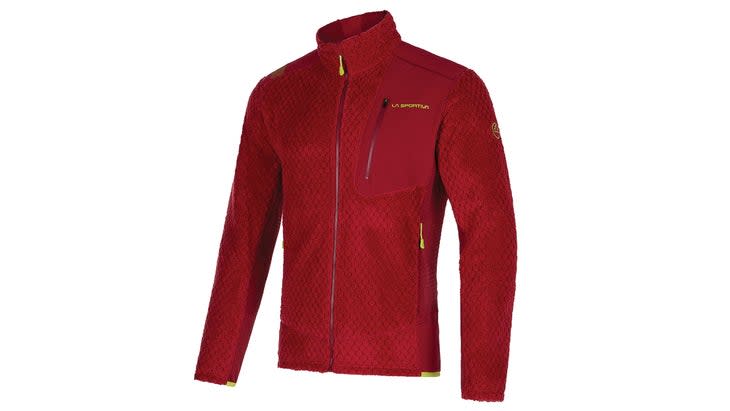
Best for: Resort skiing
Weight: 1.2 lbs
Sizes: S-XXL
This very warm fleece was our go-to insulator for resort skiing, racking up dozens of days from Whistler to Winter Park to Wildcat. It was the perfect lofty layer to slip underneath a waterproof shell on a stormy day, warm even when damp from falling snow or aggressive bell to bell riding. (Thanks also to the silver-chloride coating that kept odors in check throughout a week-long powder cycle.) Stretchy grid fleece panels along the sides and under the arms made for a dynamic fit and extra breathability when shouldering skis to access powder stashes on bootpacks like Blackcomb's Spanky's Ladder or Jackson's White Spider. Kudos for the recycled fiber content, and wear patches on the shoulders and elbows mean this fleece isn't shy of hard use.
Bottom Line: For hot laps at the resort when you don’t want to fuss with your layers
Patagonia R2 Techface Hoody ($229)
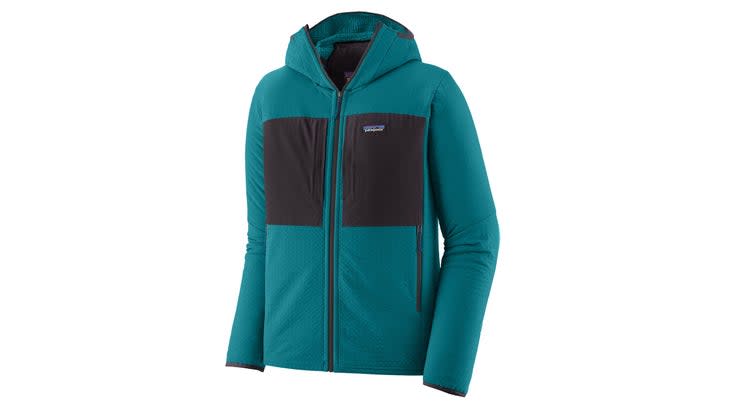
Best for: Moving fast and light
Weight: 1.14 lbs
Sizes: XS-XXL
When you need a little more from your fleece than warmth and breathability, pick up the R2 Techface Hoody. It sports high loft fleece with a more wind-and-abrasion resistant exterior, as well as a PFC-free durable water repellent treatment, but is still far more breathable and stretchy than a softshell for high output pursuits like the spring ascent of New Hampshire's Mount Washington that one tester squeezed in before dark. We loved the copious storage including twin hand pockets, chest pockets, and interior drop pockets, which came in handy when that same tester had to stash his gloves momentarily on the summit to keep them from blowing away in the mountain's notorious wind. As always, Patagonia leads the way in sustainability: the fleece is made of 91 percent recycled material and is solution dyed, which uses far less water than traditional coloring techniques.
Bottom Line: Long days in the backcountry with lots of transitions call for this hoody
Outdoor Research Vigor Grid Fleece Pullover Hoodie ($110)
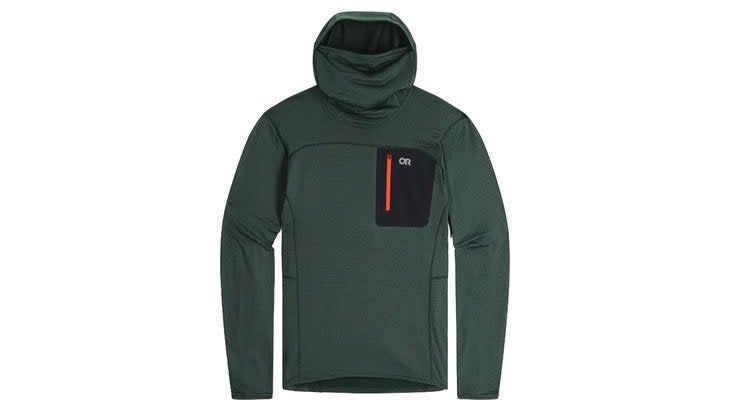
Best for: Face protection
Weight: 9.59 oz
Sizes: S-XXL
The Mount Glory bootpack on Teton Pass is a relentless 1,300-foot climb often worsened by an icy west wind that freezes the left side of your face even while the rest of your body is sweating with exertion. Enter the Vigor Grid Fleece Pullover Hoodie: a front panel of fabric hangs from the hood like a North African litham veil, shielding our tester's neck and face from the crosswind without the bulk and chafing of a tall front zipper. On calmer days, push the hood back on this super breathable fleece and it drapes like a thin scarf. The polyester/spandex blend provides impressive stretch for aerobic pursuits, and a generous zippered chest pocket is a secure stash point for essentials like a key fob or smartphone.
Bottom Line: If you anticipate windy, icy conditions, look here
LIGHT PUFFIES AND HYBRIDS
Jones Ultra Re-Up Down Recycled Jacket ($320)
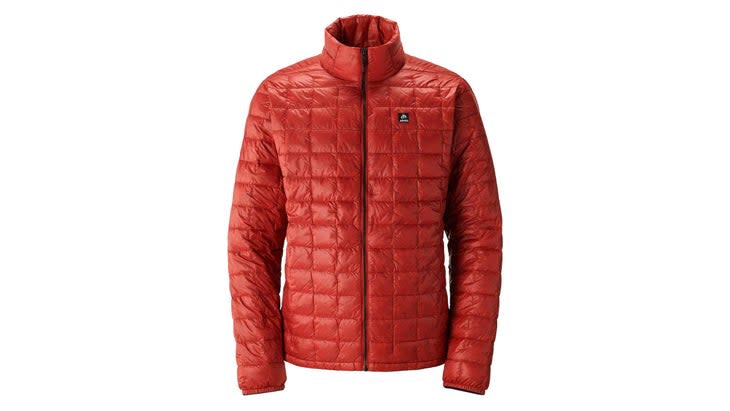
Best for: Ultralight down midlayer
Weight: 7.4 oz
Sizes: S-XL
For pure warmth for the weight, nothing beats high loft down. We love stashing a superlight safety piece like the Ultra Re-Up Down Recycled Jacket in our packs for when the temp suddenly drops on an ascent or our partner turns up underdressed. At just 7.4 ounces and stuffing down to the size of a pint glass, this one checks those boxes perfectly, and includes a PFC-free DWR treated shell to keep the jacket dry when the snow is flying. It's also easy on the environment, sporting 750-fill down reclaimed from other garments, a 100 percent recycled Pertex shell, and even zippers and pull tabs made from recycled plastic. It's not just for a crisis of course; our team loved sporting this cozy jacket for errands or apres.
Bottom Line: Reach for this full-zip when you have lots to carry and anticipate cold weather
Helly Hansen Odin Light Stretch Hooded Insulator 2.0 ($240)
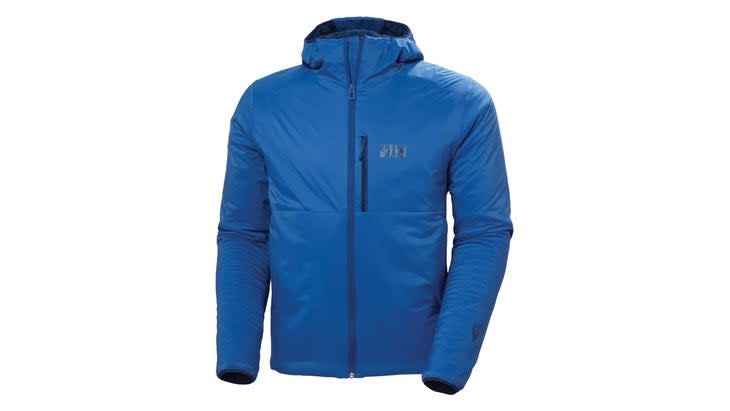
Best for: Coming in hot
Weight: 16.2 oz
Sizes: S-XXL
The problem with most synthetic insulated hoodies on the market, our test crew agreed, is that they tend to be a little too warm. We love that the Odin Light Stretch Hooded Insulator employs just 40 grams of Primaloft Gold Active Plus insulation, less than half that of many such models. So we weren't overheating anytime our heart rates approached 100 bpm, whether fat biking at Schweitzer or scrambling up Boulder's First Flatiron. The snug athletic fit kept the weight impressively low and never felt restrictive thanks to stretchy fabrics and careful tailoring such as articulated sleeves. A PFC-free DWR lends water resistance and fleece stretch panels under the arms provided extra ventilation make this the ideal mountain exercise insulator.
Bottom Line: Your best option for warmer days or lots of movement
Strafe Highlands Shirt Jacket ($319)
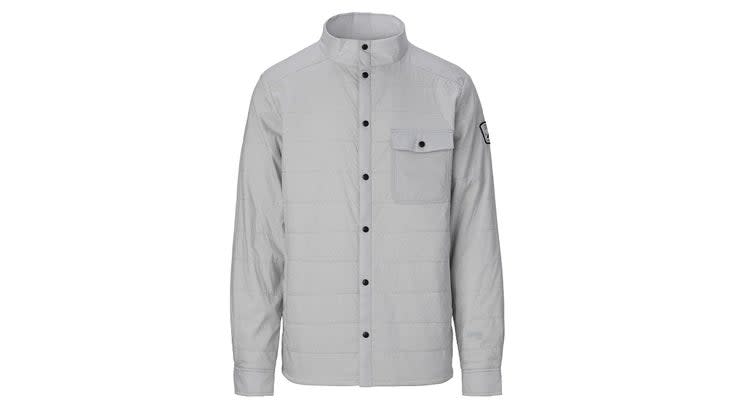
Best for: Trail to town
Weight: 10.8 oz
Sizes: S-XXL
Heading out for a Colorado ski tour doesn't mean you have to look like you are launching a siege of K2. The classy style of the Highlands Shirt Jacket hides the fact that this is a lightweight midlayer of the first rank, insulated with ultra-breathable Primaloft Active Evolve and sheathed in stretchy, supple fabrics. The snug mock neck collar sealed in heat and was a welcome change from the excess fabric of ubiquitous hoodies. Though the Highlands Shirt Jacket kept our testers warm and dry on winter missions across Northern Idaho and the Tetons, it was the shacket's steeze and coziness that stood out. "I wore this every day it was in my possession," said one tester, a Colorado teacher. "Even if my students did mock me for that."
Bottom Line: For looking good on and off the slopes with technical warmth
HEAVYWEIGHTS
Black Diamond Belay Parka ($350)
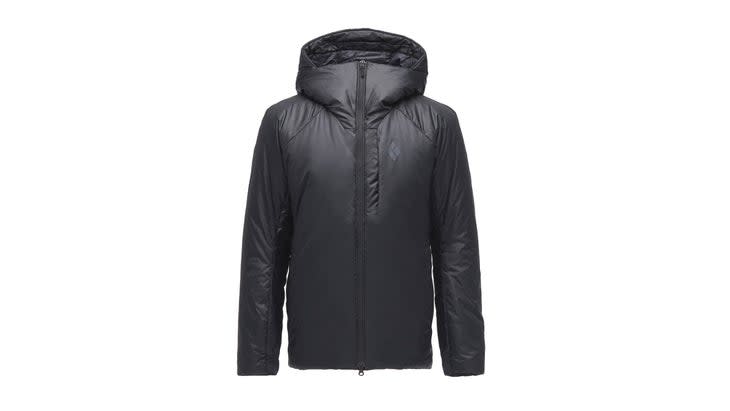
Best for: Brutal cold
Weight: 1.8 lbs
Sizes: XS-XXL
Like it says in the name, this coat is made for hanging from a cliff face in the cold while your partner is climbing. But you can use it anytime and anyplace you don't want to freeze your nether regions off, from the top of a windy skin track to shuffling in the street in jammies while your new puppy takes a leak at 2 am. Stuffed with two layers of Primaloft insulation--Gold Crosscore for the warmth-to-weight ratio and Rise to maintain that critical loft--and protected by a PFC-free DWR, this beast of a parka insulated testers in Jackson Hole 's record cold November and in a desultory New Hampshire rainstorm. It's got the amenities of an expedition piece: an adjustable, helmet-compatible hood, a two-way zipper for accessing a belay device, and underarm gussets that make it comfortable to reach overhead for your next ice tool placement. More props: the insulation contains more than 90 percent recycled material.
Bottom Line: The coldest days are no match for this parka
Rab Mythic G Jacket ($525)
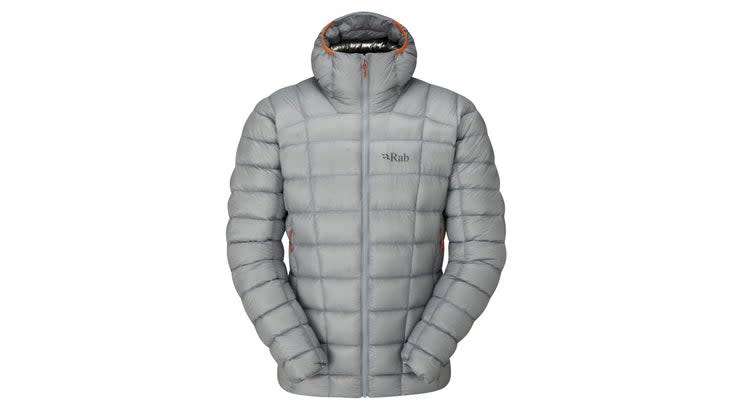
Best for: Showing out
Weight: 9.8 oz
Sizes: S-XXL
You've never worn something this light and lofty. Rab's Mythic G combines the lightest fabrics realistically possible--just 7D--with the airiest available down--1000 fill--to make what could best be described as an impersonation of a cloud. It weighs less than 10 ounces, can be stuffed into a Nalgene bottle, and is, yes, incredibly warm. It's not just the down fill that makes it so; the Mythic G also sports Rab's TILT tech, a titanium coating applied directly to the fabric's yarn that reflects the wearer's heat back to them. TILT is similar to Columbia's Omni Heat, but with much better breathability. "You do feel instantly warmer when you put it on," said one tester. Though you should take care with the remarkably thin fabric, we never punctured it in a full season of backcountry skiing. The only downside? Such finery doesn't come cheap.
Bottom Line: If you have enough of a budget, this is the warmest, lightest new jacket of the season
Columbia Arch Rock Double Wall Elite Hooded Jacket ($200)
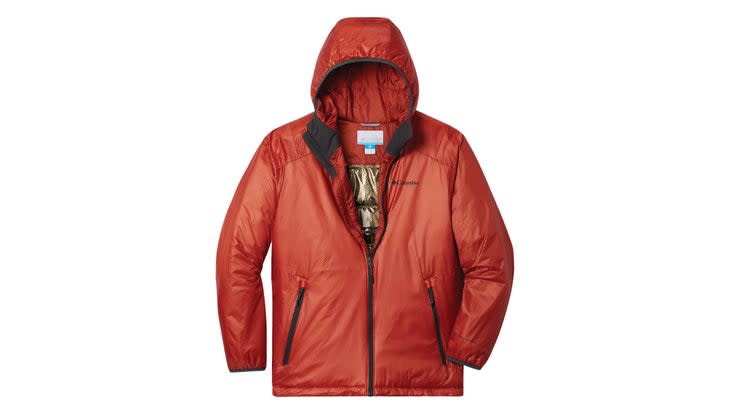
Best for: Bang for the buck
Weight: 1.1 lbs
Sizes: S-XXL; 1X-6X; LT-5XT
This synthetic fill puffer boasts an impressive weight-to-warmth ratio thanks to Columbia's latest iteration of Omni-Heat, called Omni-Heat Infinity, their body heat reflectivity system. The Arch Rock Double Wall Elite features layers of gold-reflective dots both on the jacket's liner and in the face fabric. The idea is not only to retain the wearer's body heat near the skin, but to trap it within the jacket's insulation layer, a concept lifted from NASA's astronaut suits. The result is a jacket as warm as any in the test, but with half the bulk of other synthetic fill parkas--it packs down to the size of just a cantaloupe. Use it as a midlayer or an outer layer in a pinch--it is plenty wind resistant and its DWR treatment shed even wet Whistler snow with ease. The drawback to all the reflective dots is less breathability, but we'll gladly layer a bit more carefully if it means taking advantage of the jacket's $200 price point.
Bottom Line: If you don’t have a big budget, the warmth-to-weight on this jacket is your best bet
How to Buy Men's Midlayers and Insulation
It's all in the ingredients. Down-filled layers are warmest for the weight, and have that luxurious and lofty feel, but can become all but useless when they get wet because the down clusters clump together, reducing their ability to trap heat in the garment. If anticipating wet conditions, select fleece layers or pieces insulated with synthetic fill, which are bulkier but will keep you warm when wet. Either way, the thicker the layer, the warmer, generally speaking. For especially active pursuits like uphilling and backcountry jaunts, fleece breathes best, reducing moisture from perspiration. We also love hybrid layers, which often have fleece panels along the sides and sometimes the back for breathability and a little extra stretch and shell material and synthetic insulation on the shoulders and chest to block wind and moisture while moving at a clip.
How We Test
Number of testers: 7
Number of products tested: 49
Number of test days logged: 210
Coldest temperature experienced: -33F
Highest windspeed withstood: 95 mph gusts
Layers destroyed in an electric skateboard accident: 1
We combed through bushels of the newest fleeces, light jackets, and down parkas to find a few dozen worth testing. We sent those out to a handful of avid skiers, runners, cyclists and climbers last winter and told them to get out there in the worst conditions they could find. Luckily, it was kind of a gnarly winter. Our Jackson, Wyoming-based testers skied and cycled through one of the snowiest and coldest winters on record, with 572 inches of snow falling in the Tetons and the thermometer falling to 33 below zero on one January day. Our New Hampshire testers donned Yak Tracks to run up icy trails in that humid and penetrating east coast cold, and withstood sustained 80 mph winds on a spring Mount Washington ski descent. Each of them was looking to evaluate fit, heat retention, moisture management, and weatherproofing.
Meet Our Testers
Test coordinator Frederck Reimers has a standing Wednesday ski group at Jackson Hole Mountain Resort, happily filing onto the tram whether there's a foot of fresh or 20 below temps helping firm up the moguls, both of which did happen this winter. He also skinned through Grand Teton National park in search of untracked snow and rode his snow bike on the shadowy trails of Cache Creek, often with fellow tester Aaron Japel. The rest of his test crew included Boulder, Colorado climber, skier and trail runner Chris Weber, Sandpoint, Idaho skier and snow biker Jason Munzke, and New Hampshire downhill and nordic skiers John Gartner and Jules Larson, who also tried out a couple of the parkas at a frigid April baseball game at Boston's Fenway Park. No one needs more comfort than a Red Sox fan with their team in last place, after all.
For exclusive access to all of our fitness, gear, adventure, and travel stories, plus discounts on trips, events, and gear, sign up for Outside+ today.

